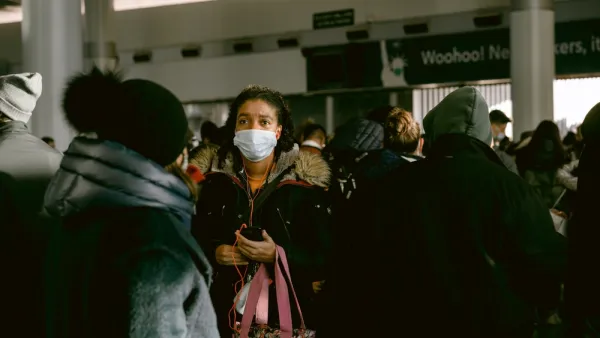The rapidly spreading Omicron variant and its viral competitor, the Delta variant, are setting new case records globally and in the U.S.

Infections from the Omicron and Delta variants have topped the previous infection record set by a close descendant of the original strain of the coronavirus, reports Jinshan Hong for Bloomberg Prognosis on Dec. 27, 2021.
The more than 1.44 million worldwide infections smashed the prior record after factoring out a day in December 2020 when Turkey backdated a significant number of cases. A more conservative gauge -- the seven-day rolling average that smooths out one-time fluctuations and holiday reporting irregularities -- is also at an all-time high, owing to a tidal wave of omicron infections.
The highly mutated and most transmissible variant yet, omicron is fast becoming the dominant strain globally as it evades immunity normally provided by vaccines and previous infections. The seven-day rolling average of cases on Monday stood at about 841,000, a jump of 49% from a month ago, when omicron was first identified in southern Africa.
The New York Times global tracker recorded the 7-day average for Wednesday (Dec. 29) at 1.015 million, +62% in the past 2 weeks. The daily average of deaths was 6,200, [–14%] in the past 2 weeks.
"Governments already are warning that infections and hospitalizations may soar following the holidays, setting a grim tone as the world heads into the third year of the pandemic," adds Hong.
The silver lining is that daily Covid deaths haven’t significantly increased. The seven-day rolling average of deaths has hovered at about 7,000 since mid-October after falling from a delta-driven peak, despite the emergence of omicron.
U.S. infection record
A record was also set in the U.S.on Monday with over half a million cases recorded according to The New York Times U.S. coronavirus tracker (click on their interactive graph titled, "New reported Cases"), meaning that over a third of the global cases recorded on Dec. 27 were Americans. The seven-day average for Dec. 28, 267,000, broke last winter's record set on Jan 11, 2021, of 251,000.
On Dec. 29, average daily cases had already topped 300,00, up 153% in the past two weeks.
In keeping with the guidance noted in a recent post given by Dr. Ashish Jha, dean of the Brown School of Public Health, here are the other two health metrics for Wednesday to consider during the Omicron wave:
- Hospitalizations: 75,500 (7-day average), +11% in past 2 weeks
- Deaths: 1,200 (7-day average), [–7%] in past 2 weeks
Not all Omicron
In an unusual correction, the U.S. Centers for Disease Control and Prevention revised the share of infections resulting from the two prevalent variants. Nathaniel Weixel of The Hill reports on Dec. 28:
According to agency data, omicron accounted for about 59 percent of all U.S. infections as of Dec. 25. Previously, the CDC said the omicron variant comprised 73 percent of all cases for the week ending Dec. 18. But that number has now been revised to 22.5 percent of all cases.
The new estimates mean that while a majority of new infections are attributed to the omicron variant, the delta variant has not been sidelined, and still accounts for about 41 percent of infections.
Weixel reminds us what to expect from so-called 'mild infections' due to Omicron which is considered to be less virulent than Delta.
While evidence appears to show an omicron infection may be more mild for people who are fully vaccinated, experts say the experience is not likely to be pleasant, and people with such infections should expect to be sick for multiple days.
Related in Planetizen:
- Your Date With Omicron, December 29, 2021
- A Tidal Wave of Omicron Coming,' December 16, 2021
- Omicron Variant: No Good Science Goes Unpunished, November 30, 2021
FULL STORY: World Hits Record Daily Covid Cases as Omicron Mars Christmas

National Parks Layoffs Will Cause Communities to Lose Billions
Thousands of essential park workers were laid off this week, just before the busy spring break season.

Retro-silient?: America’s First “Eco-burb,” The Woodlands Turns 50
A master-planned community north of Houston offers lessons on green infrastructure and resilient design, but falls short of its founder’s lofty affordability and walkability goals.

Delivering for America Plan Will Downgrade Mail Service in at Least 49.5 Percent of Zip Codes
Republican and Democrat lawmakers criticize the plan for its disproportionate negative impact on rural communities.

Test News Post 1
This is a summary

Test News Headline 46
Test for the image on the front page.

Balancing Bombs and Butterflies: How the National Guard Protects a Rare Species
The National Guard at Fort Indiantown Gap uses GIS technology and land management strategies to balance military training with conservation efforts, ensuring the survival of the rare eastern regal fritillary butterfly.
Urban Design for Planners 1: Software Tools
This six-course series explores essential urban design concepts using open source software and equips planners with the tools they need to participate fully in the urban design process.
Planning for Universal Design
Learn the tools for implementing Universal Design in planning regulations.
EMC Planning Group, Inc.
Planetizen
Planetizen
Mpact (formerly Rail~Volution)
Great Falls Development Authority, Inc.
HUDs Office of Policy Development and Research
NYU Wagner Graduate School of Public Service





























